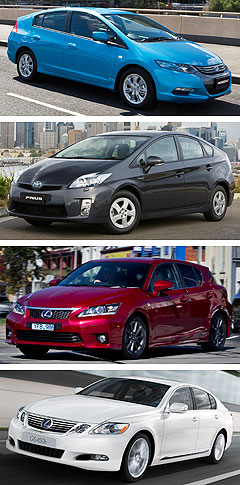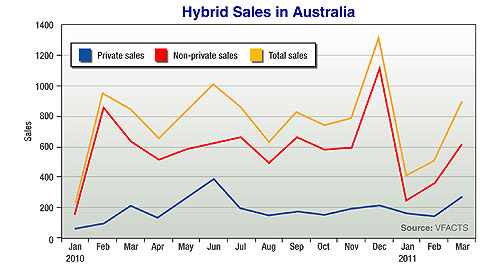News - Market Insight - Market Insight 2011Market Insight: Consumers still wary of hybridsSluggish sales: Australian sales of hybrid vehicles such as the Toyota Camry (left) are growing, but still below target. US study sees low hybrid and EV demand as Australian petrol-electric apathy rolls on2 May 2011 By TERRY MARTIN THE market share of hybrid and electric vehicles in the United States is expected to remain below 10 per cent through to at least 2016, according to new research from global marketing information company JD Power and Associates. The 2011 ‘Green Automotive Study’ released last week reaffirms conclusions made from earlier research, including a JD Power report released late last year that predicted hybrids and EVs would account for just 7.3 per cent – or 5.2 million units – of the 70.9 million passenger vehicles forecast to be sold worldwide in 2020. This latest research includes a survey in February of more than 4000 US consumers who indicated they will be in the market for a new vehicle over the next five years. JD Power says its study is also based on “information and insight” from primary consumer research, social media intelligence, forecasting and transaction sales data. And for car companies pushing ahead with hybrid and electric vehicles in the US, Australia and elsewhere across the globe, the findings again indicate that there will be plenty of fighting, in JD Power’s words, “over the relatively few consumers who are willing to drive green”.  From top: Honda Insight, Toyota Prius, Lexus CT200h, Lexus GS450h. From top: Honda Insight, Toyota Prius, Lexus CT200h, Lexus GS450h.The study, which tracks consumer attitudes toward conventional hybrids, plug-in hybrids, full EVs and ‘clean diesel’ models, found a high level of interest in alternative powertrains among a majority of Americans. General perceptions of green vehicles were also largely positive. However, JD Power concludes that “converting this interest into actual sales will require concerted efforts to improve the technology and infrastructure and reduce the cost to consumers” – most notably for the 159 hybrid and EV models the firm believes will be available for purchase in the US by the end of 2016 (up from 31 hybrids and EVs in 2009). Last year, the US recorded more than 274,000 hybrid car sales, selling almost three times the number in a single month – 28,600 in December, for example – than Australia can muster in an entire year. With 11.59 million overall sales last year in the US, GoAuto’s calculations put hybrid’s share at 2.4 per cent. Japan, on the other hand, has already passed the 10 per cent mark for hybrids. While Australia is still a minnow in EV terms and in any comparison with the vast US market, the hybrid landscape nonetheless changed dramatically here last year with the launch of the locally built Camry Hybrid in February and, late in the year, Honda’s $29,990 Insight. Total hybrid vehicle registrations more than doubled in 2010 compared to the previous year – up from 4197 to 9784 units – but, pointedly, this still represents less than one per cent of the total new-vehicle market. It is also less than the annual figure (10,000) Toyota had targeted for its Camry Hybrid alone. Of last year’s total hybrid sales, just 2292 went to private consumers, accounting for less than one in four (23.4 per cent) of the total and apparently reflecting the same sort of attitude among average Australian buyers that JD Power has found in American consumers. While people are likely to recognise the fuel-cost savings hybrids and other alternative-powertrain vehicles can offer, study participants cited significant impediments (whether actual or perceived) to ownership, including the purchase price – the number-one barrier – as well as driving range, increased maintenance costs and compromised vehicle performance. After the first quarter of 2011 in Australia – which reflects the Insight up and running and the first registrations for the new $39,990 Lexus CT200h, but not the subsequent $5000-plus price cut of the slow-selling Toyota Prius (now starting at $34,990) – hybrid sales have still fallen compared to the same period last year (1835 versus 2038) and account for only 0.7 per cent of the total market. Over these three months, Honda found only 177 Insight buyers – it forecast 200 sales a month at launch last October – and Toyota found just 167 for the Prius (down 64 per cent YTD). VFACTS figures no longer specify Camry Hybrid figures, but with just 1639 hybrid passenger vehicles sold to March 31 – and 223 of those representing the CT200h – that leaves around 1000 sales shared between several cars including the Camry, Honda’s Civic hybrid and the Lexus GS and LS hybrids. There are many new hybrid models on their way – more from established players like Toyota, Lexus and Honda, and from other mainstream and luxury marques – but, as we have documented before, the figures make it impossible not to see a striking lack of consumer commitment for petrol-electric powertrains. This is a clear warning for car-makers with grand plans for plug-in hybrids and electric vehicles in Australia – let alone more new conventional hybrid models – and, as JD Power points out in the American context, there is considerable work for manufacturers, government entities and others to do in educating consumers on the true costs and benefits of electrified vehicle technologies. Even though fuel prices are continuing to rise, JD Power argues that only through promotion and education will significant numbers of consumers become “sufficiently comfortable with both the financial investment and, in some cases, lifestyle changes required to make the leap from traditional vehicles to alternative powertrain vehicles”. “Alternative powertrains face an array of challenges as they attempt to gain widespread acceptance in the market,” said JD Power and Associates executive director of global vehicle research Mike VanNieuwkuyk last week. “It is the financial issues that most often resonate with consumers, whether it is the higher price of the vehicle itself, the cost to fuel or charge the vehicle, or the fear of higher maintenance costs. “The bottom line is that most consumers want to be green, but not if there is a significant personal cost to them.” Government incentives are considered important in the short term, but JD Power believes that ultimately the vehicle manufacturers and their suppliers will have to wear the higher costs involved in order to drive the change. “As concerns about the functionality and performance of hybrid vehicles have abated, vehicle price has become more prevalent as the primary purchase impediment,” Mr VanNieuwkuyk said. “Without a tax credit to offset the price premium, consumers must absorb all of this additional cost. Furthermore, aggressive government subsidies are unlikely to be sustainable over the long term. “Ultimately, the true cost of the technology needs to come down substantially.”  Read more29th of March 2011  Toyota sharpens Prius price knifeLexus CT200h hybrid hatch arrival signals price chop for stablemate Toyota Prius5th of November 2010  Global hybrid, EV boom ‘more hope than reality’JD Power study concludes global hybrid and EV take-up by 2020 looks to be overhyped |
Click to shareMarket Insight articlesResearch Market Insight Motor industry news |
















Facebook Twitter Instagram